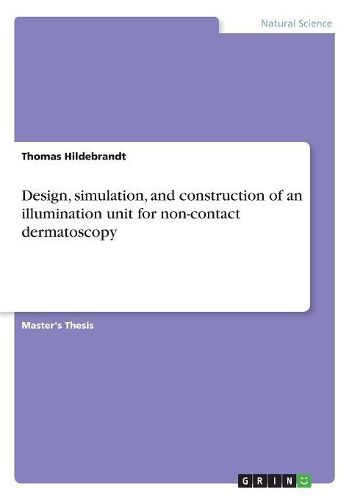Readings Newsletter
Become a Readings Member to make your shopping experience even easier.
Sign in or sign up for free!
You’re not far away from qualifying for FREE standard shipping within Australia
You’ve qualified for FREE standard shipping within Australia
The cart is loading…






Master's Thesis from the year 2018 in the subject Physics - Optics, grade: 1,3, University of Hannover (Hannoversches Zentrum fuer optische Technologien), language: English, abstract: In this thesis, an existing non-contact dermatoscope will be further developed on the basis of knowledge and experience, and established as a new prototype for dermatoscopy at the Hannover Institute of Optical Technologies (HOT).In this system, the light generated by a white LED is collimated and polarized by a lens system, and generates a homogeneous light spot at a distance of 60cm. By cross polarization, the light reflected directly onto the skin surface can be suppressed, so that only light reflected in deeper skin layers can pass through the analyzer, and contributes to the image information. Due to the difficult handling of the original device, the further developed (advanced) system was compactified and automated, taking into account the basic principle of non-contact dermatoscopy. The illumination unit used in the original non-contact dermatoscope was replaced with a newly constructed reflector in order to improve the brightness, and the homogeneity of the light spot in the target area. These two reflectors were measured with a near field goniophotometer to characterize the illuminance distribution. The conducted tests included the definition of an ideal setup of the lens system, both in practice, and in optical systems simulations by using Zemax. It could be shown that the reflectors improve the illuminance, and generates a homogeneous light spot in the target area, which homogeneously illuminates the image area of the camera. Furthermore, this system has been completely automated by providing automatic focus as well as adjustment of one of the polarizers (analyzer) used. For this purpose, a automatic focus lens was integrated on the existing objective and a mid range infrared distance sensor was installed into the system. By various tests, such as the determination of the reso
$9.00 standard shipping within Australia
FREE standard shipping within Australia for orders over $100.00
Express & International shipping calculated at checkout
Master's Thesis from the year 2018 in the subject Physics - Optics, grade: 1,3, University of Hannover (Hannoversches Zentrum fuer optische Technologien), language: English, abstract: In this thesis, an existing non-contact dermatoscope will be further developed on the basis of knowledge and experience, and established as a new prototype for dermatoscopy at the Hannover Institute of Optical Technologies (HOT).In this system, the light generated by a white LED is collimated and polarized by a lens system, and generates a homogeneous light spot at a distance of 60cm. By cross polarization, the light reflected directly onto the skin surface can be suppressed, so that only light reflected in deeper skin layers can pass through the analyzer, and contributes to the image information. Due to the difficult handling of the original device, the further developed (advanced) system was compactified and automated, taking into account the basic principle of non-contact dermatoscopy. The illumination unit used in the original non-contact dermatoscope was replaced with a newly constructed reflector in order to improve the brightness, and the homogeneity of the light spot in the target area. These two reflectors were measured with a near field goniophotometer to characterize the illuminance distribution. The conducted tests included the definition of an ideal setup of the lens system, both in practice, and in optical systems simulations by using Zemax. It could be shown that the reflectors improve the illuminance, and generates a homogeneous light spot in the target area, which homogeneously illuminates the image area of the camera. Furthermore, this system has been completely automated by providing automatic focus as well as adjustment of one of the polarizers (analyzer) used. For this purpose, a automatic focus lens was integrated on the existing objective and a mid range infrared distance sensor was installed into the system. By various tests, such as the determination of the reso